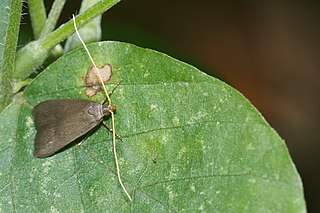Related Research Articles

The Lecithocerinae are a subfamily of small moths in the family Lecithoceridae. They are found worldwide, but most species occur in South Asia. The subfamily is characterized by the male genitalia with a bridge-like structure connecting the tegumen and the valva, and the uncus almost always is vestigal with two lobes at the dorsal base, only exceptionally united into a broad plate, but never as a thorn or spine.

Sarisophora is a genus of moths in the family Lecithoceridae.

Sarisophora leucoscia is a moth in the family Lecithoceridae. It is found in Australia and New Zealand.
Dichomeris mesoglena is a moth in the family Gelechiidae. It was described by Edward Meyrick in 1923. It is found in southern India.
Hypatima euplecta is a species of moth in the family Gelechiidae. It was described by Edward Meyrick in 1904. It is found in Australia, where it has been recorded from Queensland, New South Wales, Victoria and South Australia.
Aristotelia calens is a moth of the family Gelechiidae. It was described by Edward Meyrick in 1923. It is found in North America, where it has been recorded from California.
Aristotelia melanaphra is a moth of the family Gelechiidae. It was described by Edward Meyrick in 1923. It is found in North America, where it has been recorded from California.
Ornativalva mixolitha is a moth of the family Gelechiidae. It was described by Edward Meyrick in 1918. It is found in Morocco, Algeria, Tunisia, southern Russia, Turkey, Sudan, Iraq, Iran, Afghanistan, Pakistan, India (Bihar) and Mongolia.
Monochroa monactis is a moth of the family Gelechiidae. It was described by Edward Meyrick in 1923. It is found in North America, where it has been recorded from southern Ontario and North Carolina.
Sarisophora chlaenota is a moth in the family Lecithoceridae. It was described by Edward Meyrick in 1904. It is found in Australia, where it has been recorded from New South Wales.
Sarisophora cyclonitis is a moth in the family Lecithoceridae. It was described by Edward Meyrick in 1904. It is found in Australia, where it has been recorded from Queensland.
Sarisophora leptoglypta is a moth in the family Lecithoceridae. It was described by Edward Meyrick in 1904. It is found in Australia, where it has been recorded from Queensland.
Thubana residua is a moth in the family Lecithoceridae. It was described by Edward Meyrick in 1923. It is found in Assam, India.
Sarisophora cyanostigmatis is a moth in the family Lecithoceridae. It was described by Kyu-Tek Park in 2012. It is found in Papua New Guinea.
Sarisophora melanotata is a moth in the family Lecithoceridae. It was described by Kyu-Tek Park in 2012. It is found in Papua New Guinea.
Sarisophora lygrophthalma is a moth in the family Lecithoceridae. It was described by Edward Meyrick in 1934. It is found in China.
Sarisophora praecentrix is a moth in the family Lecithoceridae. It was described by Edward Meyrick in 1931. It is found on New Guinea.
Sarisophora tamiodes is a moth in the family Lecithoceridae. It was described by Edward Meyrick in 1910. It is found on New Guinea.
Thubana melitopyga is a moth in the family Lecithoceridae. It was described by Edward Meyrick in 1923. It is found in Sri Lanka.
Prothamnodes platycycla is a moth in the family Xyloryctidae. It was described by Edward Meyrick in 1923. It is known from Myanmar.
References
- ↑ Savela, Markku, ed. (January 13, 2015). "Sarisophora ptochomorpha Meyrick, 1923". Lepidoptera and Some Other Life Forms. Retrieved September 10, 2020.CS1 maint: discouraged parameter (link)
- ↑ Exotic Microlepidoptera. 3 (1-2): 36.
 This article incorporates text from this source, which is in the public domain.
This article incorporates text from this source, which is in the public domain.